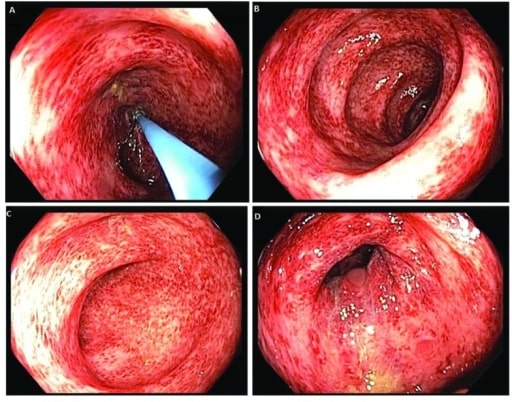Playlist
Show Playlist
Hide Playlist
Approach to Patients with GI Bleed
-
Slides Gastroenterology 01 GI Bleed.pdf
-
Download Lecture Overview
00:00 So now, let's talk a little bit more about gastrointestinal or GI bleeds. 00:05 The difference anatomically between an upper GI bleed and a lower GI bleed is the cut-off point of the ligament of Treitz. 00:13 This is in the 4th portion of the duodenum. 00:17 So, everything above that is an upper GI bleed and everything below is a lower GI bleed. 00:24 The reason why we care about that is because upper GI bleeds present differently from lower GI bleeds. 00:30 So with an upper GI bleed, patients tend to come in with melena which is dark or black-colored stools or they may have hematemesis, which is the vomiting of bright red blood. 00:43 On the other hand, lower GI bleeds tend to present with hematochezia. 00:47 This is when there is bright red blood that is passed from the rectum. 00:51 Keep in mind however, that a very quick upper GI bleed may also sometimes present with hematochezia, if the bleeding is occurring fast enough. 01:03 So, when I see a patient complaining of any one of these symptoms, I always want to make sure to ask about these important risk factors. 01:12 So, the patient's past medical history. 01:15 Have they ever had a GI bleed before? Do they have a known history of ulcers or history of infection with H. Pylori? These are some of the things I want to ask. 01:24 You also want to make sure to ask about their medications. 01:27 So do they use NSAIDs frequently? Are they on any anticoagulants or antiplatelet agents like aspirin or clopidogrel? and importantly, do they take iron supplements? This is because iron pills can actually turn the stool a dark color and may obscure the clinical picture of a GI bleed. 01:47 You also want to ask about their social history. 01:50 So, are they a smoker or do they use heavy alcohol? and in their history, you'll want to get any comorbid conditions such as cirrhosis, any renal disease or cancers. 02:04 Other associated symptoms such as dysphagia or difficulty swallowing? any unintentional weight loss? Where they vomiting frequently prior to the episode? and have they had any other changes in their bowel habits? So, that brings us to the differential diagnosis for GI bleeds. 02:21 It is quite a broad differential so we'll break it down first into upper and then lower GI bleeds. 02:30 Your historical risk factors can help you narrow down your differential diagnosis. 02:34 So, if your patient comes in complaining of bleeding with heavy NSAID use or alcohol use, your differential might include gastric or duodenal ulcers or erosive esophagitis, gastritis or duodenitis. 02:49 If they have a known history of liver disease or cirrhosis, then your differential should include: esophageal or gastric varices and portal hypertensive gastropathy. 03:00 The next thing on your differential is the arteriovenous malformation or AVM. 03:05 This is a rare cause of GI bleeding but should always be on the differential since it is always a present risk. 03:12 Next, if your patient has, describes a history of frequent vomiting, prior to presenting with bleeding, then you could suspect a Mallory-Weiss tear. 03:21 And the last thing that should always be on your differential is cancer. 03:26 Now let's move to lower GI bleeds. 03:28 In patients who describe a history of chronic constipation, you should be more concerned about diverticulosis and hemorrhoids. 03:37 Those who have a long standing history of diarrhea, along with bloody bowel movements might be concerned for inflammatory bowel disease. 03:46 Those who describe abdominal pain along with their bleeding may have ischemic colitis. 03:52 Just as with upper GI bleeds, you should always be concerned for an AVM. 03:57 and in the right patient, who just describes a history of infectious symptoms along with their bloody bowel movements, you might think of infectious colitis. 04:06 And lastly, cancer as always should be on your differential for all GI bleeds. 04:12 So now let us move to the physical exam. 04:14 There are some important physical exam findings that can help you stratify whether your patient is sick or not sick. 04:22 So, the first thing to look at is their heart rate. 04:25 If their patient has resting tachycardia, so a heart rate greater than 90 at rest, this implies that they have already lost about less than 15% of their total blood volume. 04:37 Keep in mind here though that if your patient is taking a medication that can slow down the heart rate like a beta blocker or a calcium channel blocker, then this finding may not be present and you might be falsely reassured. 04:52 The next ting you can check is orthostatic hypotension. 04:56 If your patient meets these parameters in a drop of their blood pressure from a supine to a standing position, this indicates they have already lost greater than 15% of their total blood volume. 05:07 So this is already a concerning finding. 05:10 Next, if your patient is already hypotensive while lying flat, in general we consider this a blood pressure less than 90/60, however, keep in mind that your patient's baseline blood pressure may be a bit lower so you always want to compare to their known baseline. 05:28 If they're hypotensive just lying flat, this indicates to us that they have already lost greater than 40% of their total blood volume and this is one of your sicker patients. 05:39 The next thing you wanna do is a focused abdominal exam. 05:42 This can be helpful to look for things like rebound tenderness, involuntary guarding or extreme pain when you palpate the abdomen. 05:51 These things can be helpful to look for signs of peritonitis. 05:55 Peritonitis occurs when there's a perforated organ or the patient has developed bowel ischemia. 06:03 And lastly, the most important thing you should always remember to do when seeing a patient with a GI bleed is a rectal exam. 06:12 You want to look for either grossly bloody stool or black colored melanotic stool. 06:18 In addition, you can also check for things like an anal fissure or hemorrhoids or any masses on the rectum that might help you focus your differential diagnosis a bit more. 06:31 So now let's move to laboratory studies. 06:34 There are several lab studies that you should always make sure to get in a patient presenting with a GI bleed. 06:39 The first is a complete blood count or CBC. 06:43 Here, you're looking specifically for a drop in the hemoglobin or low platelets. 06:48 Keep in mind here though that a drop in the hemoglobin may not be immediately apparent because the loss of whole blood, after the loss of whole blood, it takes time for the body to re-equilibrate and that drop in hemoglobin may be delayed by about a day or so. 07:06 The next thing you wanna check is your basic metabolic panel or BMP. 07:11 You can look specifically here for a BUN to creatinine ratio. 07:16 When the BUN to creatinine ratio is greater than 30:1, this has been shown to correlate well with the presence of an upper GI bleed. 07:25 Keep in mind though that this is only helpful for upper GI bleeds and not lower GI bleeds. 07:32 The next thing you can look at is your liver panel. 07:35 Here, you're looking specifically for signs of impaired liver synthetic dysfunction. 07:40 So, in this case, a low albumin may be helpful. 07:45 Next, you always wanna check coagulation factors to look for any coagulopathy that might exist for your patient and make it more difficult to control bleeding. 07:55 And the last thing you could check is a lactate. 07:58 Here, if you find an elevated lactate, this may be a sign that your patient has developed signs of end organ dysfunction and needs to be more aggressively resuscitated. 08:08 So let's take a brief moment to talk a little bit about further test you might do for GI bleeds. 08:14 There's a test called an FOBT or fecal occult blood testing. 08:19 As a high value care tip, this is not a test that you should use to look for active GI bleeding. 08:25 It has a very poor sensitivity and specificity for active GI bleeds and really should only be used in the screening for colorectal cancer.
About the Lecture
The lecture Approach to Patients with GI Bleed by Kelley Chuang, MD is from the course Approach to Patients with GI Symptoms.
Included Quiz Questions
Which of the following medical conditions is one of the common causes of lower GI bleeding?
- Diverticulosis
- Mallory-Weiss tear
- Gastric ulcer
- Duodenal ulcer
- Gastritis
Which of the following medications increases the risk of GI bleeding?
- NSAIDs
- Antihistamines
- Ceftriaxone
- Octreotide
- Anticholinergics
Infection with which of the following bacteria is a common risk factor for upper GI bleeding?
- Helicobacter pylori
- Clostridium difficile
- Salmonella species
- Escherichia coli
- Staphylococcus aureus
What percentage of blood loss does supine hypotension signify in a patient with GI bleeding?
- >40% of total blood volume
- <15% of total blood volume
- <17% of total blood volume
- <10% of total blood volume
- <8% of total blood volume
Customer reviews
5,0 of 5 stars
| 5 Stars |
|
1 |
| 4 Stars |
|
0 |
| 3 Stars |
|
0 |
| 2 Stars |
|
0 |
| 1 Star |
|
0 |
THE LECTURE INCLUDE All the most information about G I BLEEDING




